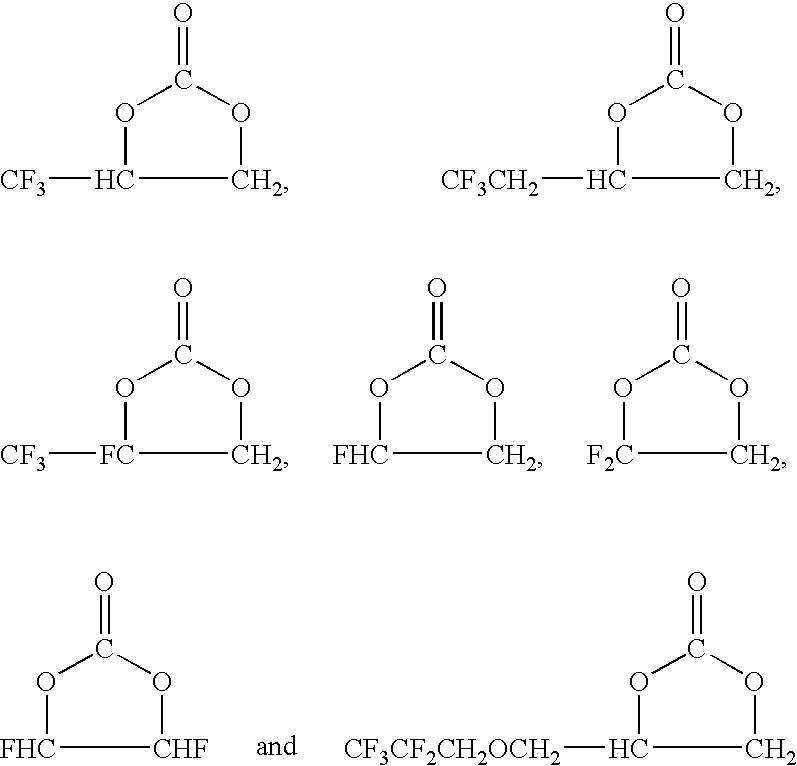Non-aqueous electrolytic solution
a non-aqueous electrolytic and solution technology, applied in the direction of non-aqueous electrolyte cells, batteries, cell components, etc., to achieve the effect of excellent non-combustibility and suitable for lithium secondary batteries
- Summary
- Abstract
- Description
- Claims
- Application Information
AI Technical Summary
Benefits of technology
Problems solved by technology
Method used
Image
Examples
synthesis example 1
Component A1
[0070]Into a 3-liter autoclave were poured 800 g (7.14 mol) of 3,3,3-trifluoromethylepoxypropane, 18.8 g (0.2 mol) of LiBr and 600 ml of N-methyl-2-pyrrolidone. After decreasing the inside pressure (100 mmHg) on ice bath, CO2 was introduced. Thereafter, while heating up to 100° C., CO2 was introduced until the inside pressure reached 1.2 MPa, and reaction was continued with stirring until decreasing of the inside pressure stopped. After completion of the reaction, the reaction solution was cooled and washed with 1 mol / liter of an aqueous solution of HCl for separation of the solution. After that, refining by distillation was carried out, and 548 g (3.5 mol) of a fluorine-containing cyclic carbonate (A1):
was obtained (yield 49%).
[0071]According to 19F-NMR and 1H-NMR analysis, it was confirmed that this product was the fluorine-containing cyclic carbonate (A1) having the above-mentioned structure.
[0072]19F-NMR: (neat): −79.1 to −83.2 ppm (3F)
[0073]1H-NMR: (neat): 4.44 to 4...
synthesis example 2
Component A2
[0076]Into a 3-liter autoclave were poured 174 g (3.0 mol) of allyl alcohol, 49.2 g (0.3 mol) of α,α′-azobis isobutyronitrile (AIBN) and 300 ml of ethyl acetate. After decreasing the inside pressure (100 mmHg) on ice bath, N2 was introduced, and the inside pressure was decreased again. Thereafter, 588 g (3.0 mol) of CF3I was introduced and the mixture was slowly heated up to 60° C. After completion of the reaction, the reaction solution was cooled and washed with 1 mol / liter of an aqueous solution of HCl for separation of the solution. After that, refining by distillation was carried out, and 533 g (2.1 mol) of a fluorine-containing iodide (a):
CF3CH2CHICH2OH
was obtained.
[0077]Next, into a 200 ml four-necked flask were poured 60.1 g (0.24 mol) of the fluorine-containing iodide (a), 20 g (0.36 mol) of KOH and 100 ml of H2O, followed by four-hour stirring at 60° C. After completion of the reaction, the reaction solution was washed with 1 mol / liter of an aqueous solution of ...
synthesis example 3
Component A3
[0084]Into a 500 ml autoclave were poured 93 g (0.62 mol) of pentafluoropropanol:
CF3CF2CH2OH,
173 g (1.87 mol) of epichlorohydrine, 52 g (0.93 mol) of KOH and 6 ml of H2O. While cooling the reactor of the autoclave with ice, the mixture was stirred, and when heat generation was stopped, the reaction was terminated. After completion of the reaction, the reaction solution was washed with 1 mol / liter of an aqueous solution of HCl for separation of the solution. After that, refining by distillation was carried out, and 98 g (0.47 mol) of a fluorine-containing epoxide (b2):
was obtained.
[0085]Next, into a 500 ml autoclave were poured 214 g (1.04 mol) of the obtained epoxide, 4.52 g (52 mmol) of LiBr and 200 ml of N-methyl-2-pyrrolidone. After decreasing the inside pressure (100 mmHg) on ice bath, CO2 was introduced. Thereafter, while heating up to 100° C., CO2 was introduced until the inside pressure reached 1.2 MPa, and reaction was continued with stirring until decreasing of ...
PUM
 Login to View More
Login to View More Abstract
Description
Claims
Application Information
 Login to View More
Login to View More - R&D
- Intellectual Property
- Life Sciences
- Materials
- Tech Scout
- Unparalleled Data Quality
- Higher Quality Content
- 60% Fewer Hallucinations
Browse by: Latest US Patents, China's latest patents, Technical Efficacy Thesaurus, Application Domain, Technology Topic, Popular Technical Reports.
© 2025 PatSnap. All rights reserved.Legal|Privacy policy|Modern Slavery Act Transparency Statement|Sitemap|About US| Contact US: help@patsnap.com



